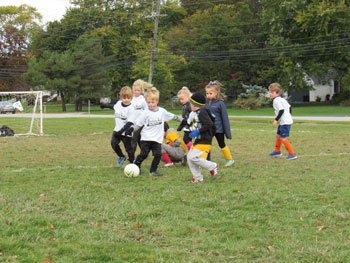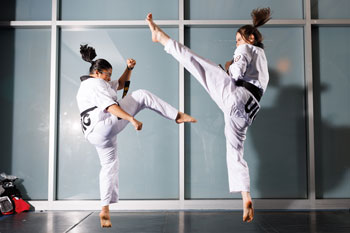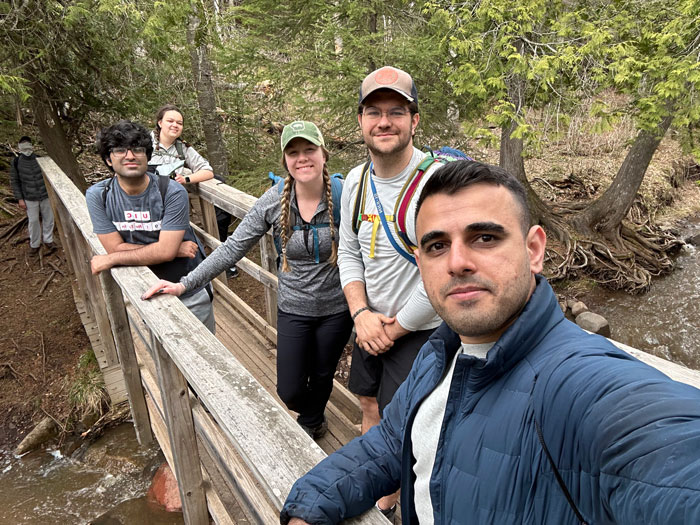For those looking to “get out of the house,” it seems there is no shortage of things to do. Activities abound for kids, seniors and everyone in between, whether looking for exercise, recreation, competition, socialization or relaxation. But with so many options, how do parks, fitness clubs, community rec centers and schools attract people to their facilities and programs and keep them coming back? Marketing strategies, updated offerings, and maintaining clean and inviting facilities can all help boost interest and participation.
At the University of Illinois, Chicago (UIC), the campus recreation program aims to “…provide dynamic and diverse recreational experiences,” and 93% of students participate in campus rec facilities, programs or services. They oversee an array of aquatics programming, fitness and wellness offerings, rec programming and outdoor adventure outings. In addition to traditional sports offerings, their intramural program also offers dodgeball, cricket and pickleball. Their robust club sports program—featuring 26 student-led clubs—offers boxing, dance, archery, fencing, Ultimate Frisbee and snowboarding.
Lynne Thompson is interim director for the department of campus recreation at UIC, and when it comes to engagement, she said it’s always important to be monitoring trends and evaluating opportunities to offer new types of programs. “Though the traditional sports will always have high interest, new sports provide an opportunity to connect with nontraditional participants and allow for the intramural program to build new communities of active individuals within the program.”

City of Broadview Heights, Ohio
UIC students will sometimes suggest new offerings, and Thompson said they work to incorporate those requests in future programming in some capacity. “It’s important to keep all program areas updated and fresh, and that looks different for various programs.” For example, with their climbing wall, she explained that regularly updating routes allows for additional challenge and mastery. “Adding trending classes and music for fitness increases energy and excitement in class.”
And to engage more users, it’s important to note that while some are seeking competition, others simply want to have fun. “The intramural sports program is intended to be a more fun recreational environment with games on campus against other UIC students, whereas the sport club program is a more competitive environment with games both on and off campus against other university teams.”
Of course, there are many people who aren’t looking for physical sports or team activities, and facilities and programs need to cater to these individuals too. At UIC, there are tournaments and opportunities to participate in things like poker, chess, bags, table tennis and esports. In fact, their newest addition is The Gauntlet, a space offering opportunities to compete in various games on PCs, as well as a variety of console games to play. Users can check online for open devices.
The esports program is extremely popular, according to Thompson, with both drop-in play opportunities and a competitive gaming club. But unlike, say, basketball, things evolve quickly in the cyber world. “We spend a minimum of two to four hours a week updating games and software to stay current with any recent changes to the various platforms. Additionally, in order to stay current with industry trends in terms of hardware, the equipment is on a structured cycle so we can continue to offer a high-quality experience.”
But no matter how many programs or services an entity offers, they still need to continually inform and update patrons, to keep current users coming back and to engage potential new ones. At UIC, Thompson said that in addition to traditional methods of print materials and web presence, they have a team of students creating content for their social media platforms, to involve students and keep content fresh and relevant to their peers. “We also collaborate with departments such as the Center for Student Involvement, UIC Today and Student Affairs Events, creating programs and events on their platforms to broaden our reach.”

Thompson said they’re also very involved with orientation, spreading the word early to make sure first-year and transfer students are informed because “retaining them is much easier than finding them! We have a targeted email system through our management software that personalizes the message to the receiver, increasing the likelihood that they’ll open the message. We do find that when we ask how they heard about a program or event, email is still heavily mentioned.”
In fact, these newer technologies are becoming more commonplace in assisting facilities with their operations, including engagement. “We want to make it easier for patrons by removing any friction points in the experience, and then collect information about their actions so we can look into the future to further improve processes and help make smart decisions about programming,” said Joshua Karson, senior sales manager with an Essex Junction, Vt., company specializing in recreation management software and other solutions. He said membership and club software can simplify the registration process by offering online registration and self-service portals, enhancing the user experience and reducing administrative burdens, making it easier for customers to participate in programs.
Karson explained how the software enables users to view and securely sign up for activities online, and pointed out that automated reminders can minimize no-shows and membership expirations, as well as inform about other events or programs.
Regarding the UIC software management system, Thompson said they recently transitioned from a desktop application to a web-based platform to include a phone app for ease of use for students and members. Another solution is used for operations throughout all facilities to have centralized software for daily reports, event setup and task reminders for student staff. This is integrated with another platform used for all facility scheduling throughout the university for event and academic spaces. Staff schedules are created utilizing another program.
She added that even post-pandemic, having a virtual community is important for multiple reasons. “As an urban institution we’re primarily a commuter campus. Additionally, with increased online, blended academic content, many students are not always on campus, so providing resources for students regardless of location is important.”
Karson believes that social media is a strong—and cheap—tool for reaching a broader audience, enhancing both diversity and inclusion. “It’s not just those who can make it to the office or subscribe to the paper. This allows patrons to easily share information regarding their purchases and interests for offerings from programs, camps, events, memberships and more, bringing in other patrons who without the social media post would not be aware of the offerings.”

And texting continues to be a popular method of communication for facilities, according to Karson, as this enables the conveying of time-sensitive information, such as program updates, event reminders, schedule changes or facility closures in real time. “Everyone has their phone and relies on them continuously and expects to receive time-sensitive communications there.”
And what about the good old website? “Websites remain a crucial tool for increasing engagement and participation in today’s digital landscape,” said Karson. “They serve as the hub for everything at some level.”
Amanda Hutcheson, director of parks and recreation for the city of Broadview Heights, Ohio, said their website is still a critical engagement tool. “We put everything possible about what we do on our website; we tell everyone to go to the website.”
She said they also utilize the major social media outlets and use a program for emailing, as well as using rec management software for online registrations and QR codes.
There’s a full slate of sports, aquatics and fitness offerings for all ages in Hutcheson’s district, including newer trends like pickleball, and she said it’s absolutely important to experiment with new offerings to stay fresh, explaining that they want to reach a bigger community base. “Our new disc golf course is the only one in the area, and it gets a very high rating on udisc.com.”
But they also offer non-sports activities and programs to include a larger audience, including arts and crafts, babysitter training, chess, dance, theater, etiquette classes, first aid and CPR, and tech camp and other day camps. “You need to have a mixed bag of programs to offer for families,” said Hutcheson. “We firmly believe it should not just be sports. These programs also enhance the days off the kids have from school, filling gaps.”
And what about networking with others in the parks realm, to see what new programs might be working for them? “I’m a Region Two co-chair for the Ohio Parks and Recreation Association and we have two meetings a year, and we have roundtable meetings with other groups as well in northeast Ohio,” said Hutcheson. “This allows questions and issues to be presented and new ideas to come to fruition.”
They also stage special events during the year that draw folks out, which might include holiday events, a 5K run or a Trike & Bike ride to benefit charity. “Community events are a huge bonus for us here,” said Hutcheson. “Most events are free, and we offer them at various times throughout the year. During those events we do promote the (rec center), the programs and the athletic events. We often see the residents who are members of the (rec center) at these large events, and it gets a little more personal.”
At UIC campus recreation, while they do prioritize space for students, they are a full-service facility providing membership options to faculty/staff, alumni and community members as well, engaging a whole other group of potential users. “By offering these additional users memberships to our facility, we offset costs and the students benefit from the added revenue generation,” said Thompson. She explained that they can provide financial equity for students by offering a sliding scale for the programs, services or rentals that have additional fees associated with them.
In St. Charles, Ill. (STC), the public library is, well, not your parent’s library. Which is to say that these days, some library systems are looking way beyond books, to engage a much larger portion of the communities they serve. In fact, the STC library has a Beyond Books program, an expansion of the technology items they’ve previously offered, according to Young Adult Librarian Brandon Buckley. “Library patrons have been able to check out laptops, board games, projectors, screens, mobile hotspots and digitization devices for years. This year, we’ve rebranded and expanded our offerings, adding musical instruments, tools, puzzles, cameras and much more. Some of the newer items are a banjo, mandolin, drill, binoculars, telescope, knife sharpener, yard games, sewing machines, radon detector, karaoke machine, streaming devices and a green screen.”
Buckley explained that one of the goals of the program is to let patrons try something out before they buy it, as well as lending items that someone may only need once. And it engages a whole new audience, as seen at a recent open house to promote the program. “It was a huge success! We had a lot of families attend. We had a selection of our Beyond Books items out for patrons to try, and we answered a ton of questions.”
But besides lending a myriad of items, the library also offers many activities and events, including a book club geared toward adults in their 20s to 40s that meets at local brew pubs. There are concerts and movies at the library, genealogy programs, trivia nights, cooking demonstrations, computer and business programs and crafts and maker tool demonstrations, plus many offerings for young adults and smaller children.
Through their seed exchange program, the library offers free heirloom and open-pollinated seeds to the community, which they purchase as well as receive donations, and Buckley said the program has exploded since many people took up gardening during the pandemic. “We gave out 5,000 seed packets in 2022 and around 7,000 this year.” They also plant raised garden beds and use them to support library programs. “Starting last year, we lent two of the beds to a local elementary school and a local church, who are growing a pollinator garden and a salsa garden respectively. We also lent use of a bed to the Fox Valley Special Recreation’s Adults with Disabilities program.”
And to cast an even wider net in the community, the library often collaborates with local businesses and organizations, according to Buckley. They’ve joined with the local forest preserve district to present programs and have presented movies in the park, story times, field trips and teen programs in conjunction with the local park district, winning an Illinois Association of Park Districts award for Intergovernmental Cooperation.
STC Library has a Communications and Marketing department, and Buckley said they utilize social media and mail a quarterly newsletter to everyone in the district. There’s also a digital newsletter and a semi-monthly column in the local newspaper. “We send information and make visits to local schools.”
And he said they’ve updated their entire website, which features streaming links, downloads, research databases and library catalog. “Library patrons can view the events calendar and sign up for library programs. We also have Zoom accounts for virtual programs.” And they utilize different software programs for payments, sign-ups, scheduling, book lists, the email newsletter and more.
And while new technologies are great for facilities and staff when it comes to engagement and streamlining operations, there are still some fundamental strategies to help attract and retain customers, like offering clean, inviting and updated amenities. Does Hutcheson think this is important? “For us, 100%. We have six full-time custodians and several part-time. We have daily, monthly and yearly checklists, and the night supervisors always check the building and report back any issues. We have a high standard and want to keep people coming back.”
Thompson agreed. “Cleanliness is one of the most important expectations we have, along with safety and providing a welcoming space to find belonging on campus.”
In fact, offering a sense of belonging is the UIC mission, according to Thompson, and the university maintains an Inclusive Recreation program, adaptable fitness and aquatics equipment, gender-inclusive changing rooms, ADA access and staff trained on inclusivity practices. “Being inclusive, having equitable access and programming, and showing respect to everyone is how we meet this mission. Anything we can do to try to reach 100% of our student population in some format and offer them an avenue to positively improve their well-being is a definite yes from our team.”
Another way to engage people and foster community at UIC is through their Outdoor Adventure offerings, which might encompass a day or a weekend, and Thompson said the program attracts students from all over campus. “Most students attend our trips without knowing anyone else first. They learn how to interact in a new environment, with new people, and by the end of the trip they’ve made new friends and connections.”
Karson pointed out that each of their customer’s communities has different demands, so it’s important to use their software’s reporting and analytic tools to determine which programs, memberships, amenities, etc., are being used most frequently. “The offerings a customer provides should not remain static and should be analyzed frequently, because the patrons and their interests are continuously changing. You have to look ahead and be flexible to anticipate and meet their needs.”
At the STC Library, they just finished a community survey—on both paper and digital formats—to help guide them as they create a strategic plan for the future, according to Buckley. “We always want to stay relevant and meet the needs of the community. Our mission statement is ‘To support the growth and creativity of the individual and foster the spirit of the community and local economy.’” RM



